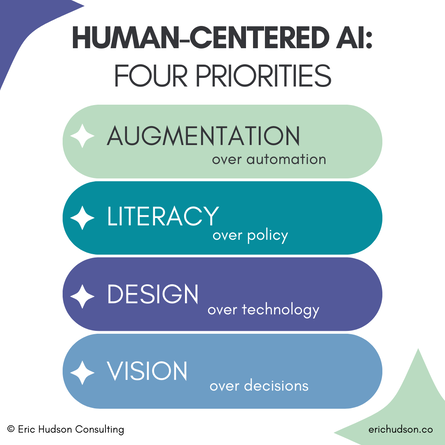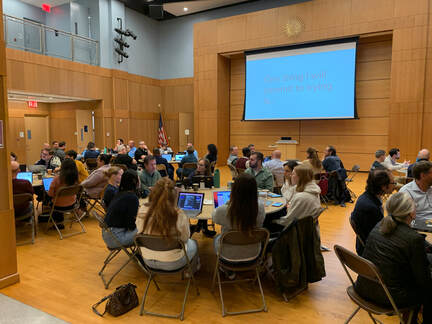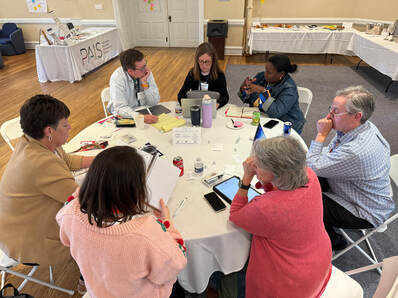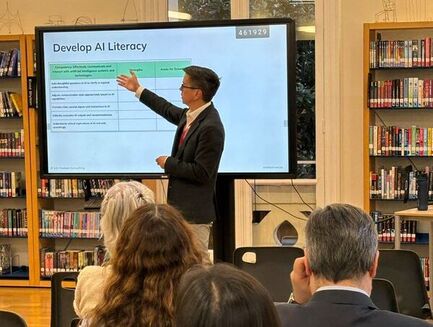Artificial Intelligence in Education
A Human-Centered Approach to Generative AI

I've articulated four priorities for human-centered AI in schools: augmentation over automation, literacy over policy, design over technology, and vision over decisions. I use these priorities with schools as a way to make decisions that ensure their approach to AI is sustainable, strategic, and human-centered.
These priorities also shape my own work. By providing accurate, relevant information about AI and facilitating hands-on learning experiences, I aim for participants to recognize AI's power and its pitfalls and to understand how their own work and learning will (and will not) change in response to an AI world. Whether I'm working with teachers, leaders, boards, families, or students, I want people to leave my sessions more informed and more empowered to make good decisions about AI.
You can find more detail on my work below. A list of my current and past clients is available on the About page.
For Educators: AI Literacy

If we want our students to develop AI literacy, it's important that we build that same literacy in educators. In my introductory sessions for educators, I lean on Stanford University's four pillars of critical AI literacy: functional, rhetorical, ethical, and pedagogical.
In these half-day workshops, we begin with a level-setting presentation on the current state of generative AI. This includes discussion of student and employee uses of generative AI to help better understand our own boundaries for "appropriate" and "inappropriate" use. We transition into hands-on work in an "AI Playground." I provide a menu of guided activities, and participants select those that are relevant to their work and try them on their devices. We make time and space for practice, sharing, and reflection.
For Educators: AI and the Design of Assessments

Of the many ways generative AI has disrupted education, it presents the most challenges and opportunities to learning and assessment. In this program, designed for classroom educators of any subject, we do hands-on work with and without generative AI to imagine how we can respond in a way that supports student learning.
Every participant brings a signature assignment (usually a summative assessment or project). We deconstruct that experience into essential tasks, use our colleagues and generative AI to better understand the ways in which that assignment could be vulnerable to inappropriate AI use, then we design potential "AI-resistant" and "AI-assisted" responses, using examples from research and other schools as inspiration.
For Leadership Teams and Boards

My work with leadership teams and boards on AI includes:
- Articulating a clear, mission-aligned position on AI's role in school
- Setting policy guidelines that reflect school position and offer guidance for students and teachers on responsible use
- Using strategic foresight to consider the long-term implications of AI on education and the design of school
- Practice with AI tools on leadership-specific skills and tasks
For Students and Families

I speak with students and families to facilitate more open, informed communication with the school about AI's role in the learning process. My sessions with students and families tackle a few key questions:
- How do we become critical users of AI so that we understand AI's capabilities and limitations, the ethical concerns embedded in its design, and the essential role that human knowledge plays in effective use?
- What do we need to know about how learning happens in order to make good decisions about when to use AI and when not to use it?
- What impact is AI having in the world beyond school?
For Professional Staff

I work with staff at schools and nonprofits on how AI can support professionals in the workplace. After we establish clarity about the variety of ways AI can support knowledge and administrative work, we identify tasks and goals in our roles where AI might offer assistance or partnership.
As with teachers, I make time and space for professionals to practice guided activities with AI tools. These exercises support their technical skill with AI, but also spark new questions and ideas about how AI can be used to support the work of the organization and the staff.